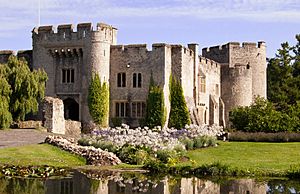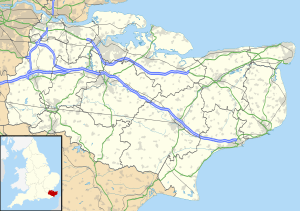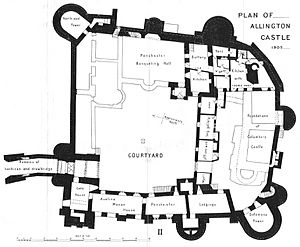Allington Castle facts for kids
Quick facts for kids Allington Castle |
|
|---|---|
| Allington, Kent, United Kingdom | |

View of Allington Castle
|
|
| Coordinates | 51°17′36″N 0°30′42″E / 51.293333°N 0.511702°E |
| Site information | |
| Owner | Sir Robert Worcester |
| Condition | Restored from ruins |
| Site history | |
| Built | 1279-99 |
| Built by | Stephen de Pencester |
Allington Castle is an old stone castle in Allington, Kent, England. It's located near Maidstone and is surrounded by a moat (a deep, wide ditch, usually filled with water, that surrounds a castle).
The very first castle here was built without permission in the 1100s during a time of civil war called The Anarchy. It was later torn down by the king. A manor house (a large country house) was built in its place. In the 1200s, this manor house was allowed to be fortified (made stronger like a castle) by the king. Over the years, different owners added to and changed the castle. It became a strong place with six towers and many buildings inside, including one of England's first "long galleries" (a very long room, often used for walking or displaying art).
In 1554, the castle was taken by the Crown (the king or queen) because its owner, Sir Thomas Wyatt the Younger, led a rebellion against Queen Mary that failed.
After this, the castle slowly fell apart. Fires, neglect, and even people damaging it meant it was mostly a ruin by the early 1900s. Luckily, Sir Martin Conway and his wife saved it and spent many years restoring it. For almost 50 years, a group of Carmelite friars and nuns lived there. Since 1999, it has been a private home again and belongs to Sir Robert Worcester, who started the MORI polling company. Allington Castle is a very important historic building (a Grade I listed building) and is sometimes used for weddings, but it's not usually open to the public.
Contents
History of Allington Castle
Early Days: From the 1100s to the 1400s
The first castle at Allington was built by William de Warenne, 2nd Earl of Surrey around the 1100s, during the time of King Stephen. It was a type of castle called a motte and bailey, which had a mound of earth with a tower on top and a walled courtyard below. This castle was built without the king's permission, so King Henry II ordered it to be destroyed in 1174. A smaller, unfortified manor house then took its place.
The castle you see today was built between 1279 and 1299 by Stephen de Pencester. He was a powerful person who was given special permission by King Edward I to add defenses to his manor house. After Stephen, the castle was passed down through his daughter to the Cobham family, who owned it until 1492.
Even though it had defenses, Allington Castle was more of a comfortable home than a strong military fortress. It even used a lot of brick, which was quite new for castles at that time. However, by the late 1300s, records show the castle was in very poor condition.
The Wyatt Family's Time
In 1492, Sir Henry Wyatt bought Allington Castle. He was a strong supporter of Henry Tudor, who later became King Henry VII. Henry Wyatt made many big changes to the castle. He added a two-story building that included what might have been one of England's first "long galleries." He also built a half-timbered section for the castle's kitchens and stables.
Both King Henry VII and his son, King Henry VIII, visited the castle. King Henry VIII visited several times, and it's said he was so worried about his safety that he had the only entrance to his room blocked up with a stone wall every night he stayed there! Other important people like Cardinal Wolsey and Catherine Parr also visited.
Sir Henry's son, the famous poet Thomas Wyatt, was born at the castle in 1503. However, in 1554, his son, Thomas Wyatt the Younger, lost the castle. He led an unsuccessful rebellion against Queen Mary. The rebels even had their first meeting at Allington Castle. After the rebellion failed, many of the rebels were held prisoner in the castle. Sir Thomas was executed, and his family lost their lands. Many of the surviving family members moved to America.
The Castle Falls Apart
In 1568, John Astley, who worked for Queen Elizabeth, was given the castle. But he didn't live there. Around 1600, two farmhouses were built on the castle grounds, and the rest of the castle slowly became a ruin.
A big fire in the late 1500s destroyed much of the Great Hall and a part of the castle's north-east side. In the early 1600s, a person renting the castle, John Best, removed the battlements (the top parts of the walls with gaps for defense) and added a new wooden second floor to some parts of the castle. The Best family were Catholics, and they even had a secret room, called a priest hole, in the gatehouse lodge. This was a hiding place for priests during a time when Catholics were often persecuted.
In 1720, Sir Robert Marsham bought Allington Castle. He was a descendant of the Wyatt family, but he also didn't live there, and the castle continued to decay. The famous artist JMW Turner even drew sketches of its ruined state in 1798.
Another fire in the early 1800s destroyed the top part of the Long Gallery. A few decades later, Charles Marsham, the 5th Earl of Romney, almost had the rest of the castle torn down. Local people, especially the church rector, stopped him, but by then, the castle was completely ruined. Parts of it were even used as a quarry (a place to get building materials), and the ground floor of the Long Gallery was turned into farmhouses.
Bringing the Castle Back to Life
In 1895, a lawyer named Dudley C. Falke rented the castle and started trying to restore it. But it was too expensive for him. In 1905, he contacted Sir William Martin Conway, a famous mountaineer and mapmaker, who was looking to buy an old castle.
When Sir Martin and his American wife, Katrina, saw Allington Castle for the first time, they were amazed:
Neither of us will ever forget the lovely June morning when we set forth to visit this faery castle on our way to Brighton. ... No sign of any castle could be seen (though we were evidently close up to the Medway) till we turned a corner, and there it was near at hand. Its walls and five visible towers were buried in ivy. Most of its moat had been filled in, but its reflection lay upon the calm face of the remaining fragment. ... The beauty of it all was entrancing. It took our breath away, and for a moment we were speechless. Then we both gasped out, Of course we must have it.
Conway bought the castle for £4,800. He spent the next 30 years restoring it with the help of architects W. D. Caroe and Philip Tilden. He used his own money and his wife's family wealth. A local building company, Corbens, did the work, using traditional methods. Conway and his daughter Agnes, who was an archaeologist, also studied the castle's history deeply.
Much of the restoration was finished by 1914, when the First World War began. The gatehouse, the Penchester wing, and most of the old keep were restored. The Long Gallery was rebuilt, and an old dovecot (a building for doves or pigeons) was fixed up for Agnes Conway to use as a study. After the war, Lord Conway cleared away old farm buildings outside the castle walls and created beautiful gardens. The Great Hall was rebuilt by 1927, and the north-east wing was finished by 1932.
Lord Conway passed away in 1937, and Agnes inherited the castle. The restoration work stopped because there wasn't enough money. The castle was rented out for a few years. After Agnes died in 1950, her husband sold the castle to the Order of Carmelites for £15,000. In March 1951, it became home to Carmelite Friars. This was a bit ironic because the Wyatt family, who once owned Allington Castle, had taken over Aylesford Priory (a religious house) from the Carmelites during King Henry VIII's time. Now, the Carmelites were moving into the Wyatts' old home!
The Carmelites managed the castle and did more repairs. It became a center for religious work. More renovations were done to create living spaces. In 1972, Allington Castle became its own independent priory (a small monastery). The friars eventually left the castle in 1999. Today, it is the home of Sir Robert Worcester, who founded the MORI polling company. The castle is not open to the public, but it is used as a wedding venue. It has been a Grade I listed building (a building of exceptional historical interest) since 1951.
Castle Design and Features
Allington Castle is shaped like an uneven four-sided figure. It has a strong outer wall, called a curtain wall, with six round towers of different sizes. The main entrance is through a gatehouse on the north-west side, which includes parts of the original manor house.
The biggest tower is Solomon's Tower, which has four stories and sticks out from the south-west side of the wall. Near it is the Penchester Lodgings, one of the oldest surviving parts of the castle. The main dining hall and living areas were against the east curtain wall. Most of this has been rebuilt, but the porch from the 1400s is still original.
Inside, the castle used to be one big open space. Now, it's divided into two courtyards: a large outer one and a smaller inner one. The inner courtyard seems to be where the very first castle stood, based on old foundations found during the restoration. The building that separates the two courtyards has the Long Gallery on its upper floor and offices below. The buildings in the south-east corner used to be the kitchens and a buttery (a room for storing food and drinks).
The castle was once completely surrounded by a flooded moat, which was crossed by a drawbridge. A portcullis (a heavy, grated gate) would close the entrance. You can still see the ruins of a barbican (a fortified gatehouse) on the other side of the moat. A short distance south-west of the castle, there's a low mound, which is all that's left of the original 12th-century motte.
Allington Castle in Film and TV
In Film
Allington Castle was used for filming the 1975 children's movie Robin Hood Junior. This film was made by the Children's Film Foundation (CFF) and starred Keith Chegwin as a young Robin Hood. The castle was shown as Locksley Castle, the home of Lord Gilbert during the time of the Crusades.
In Television
The castle was also a filming location for the 1965 episode "Castle De'ath" from The Avengers TV series.
It was also used for the outside shots of Covington Cross castle in the 1992 TV series Covington Cross.
Allington Castle in Music
The castle was used to film the music video for the song "Lover Chanting" by the Swedish band Little Dragon.







